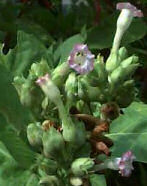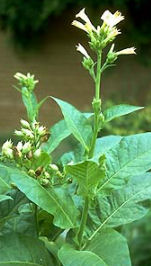Pyridine Alkaloids
Pyridine alkaloids are similar to piperidine alkaloids except that their heterocyclic ringed, nitrogen containing nucleus is unsaturated. Two toxic alkaloids will be discussed here. The pyridine alkaloid, nicotine, and the piperidine-pyridine alkaloid, anabasine. Both of these are found in plants in the Nicotiana spp. which includes cultivated, wild, and tree tobacco.
Nicotiana spp. (Tobacco and Tree Tobacco)

Domestic tobacco (N. tabacum ) is widely cultivated throughout the southeast United States. Wild tobaccos (N. attenuata and N. trigonophylla ) are upright, leafy evergreen plants found in sandy, arid regions of the western US. Tree tobacco (N. glauca ) is similar in appearance but can grow to be a small tree and is found at low elevations of Arizona and California.
Tobacco has large, simple, alternate, bright green, often sticky , leaves. Its stems are often sticky and hairy.
Tobacco flowers are organized in panicles. They have a tubular shape with 5 fused petals that flar at the mouth into 5 distinct lobes. they are fragrant and range in color from white to a very light pink, purple, or yellow.
More information describing them is available under the listing for Nicotiana tabacum, Tobacco, in the Canadian Poisonous Plants Information System, courtesy of Derek B. Munro.
Symptons of Poisoning

Nicotine
- acutely affects the nervous system by blocking autonomic ganglia and neuromuscular junctions. Livestock progress from:
- excitement
- shaking and twitching
- rapid breathing
- staggering
- weakness and prostration
- coma
- descending paralysis of the central nervous system
- to death by respiratory failure.
Anabasine
- Research indicates that anabasine is a teratogenic agent but nicotine is not.
Poisoning due to consumption of tobacco leaves and stalks has been documented in cattle, horses, sheep, and swine as well as dogs and even humans (after consuming the leaves as boiled greens). Nicotine was a popular old time wormer and insecticide that occasionally poisoned livestock as well as its intended target. Swine will readily eat the soft pith of tobacco stalks and extreme care must be taken to keep them from gleaming tobacco fields or discarded stalks. Deformed offspring due to ingestion of the anabasine alkaloid in tobacco have been documented in cattle, sheep, and swine. These deformities are clinically the same as those caused by maternal consumption of lupine or poison hemlock (carpal flexure, cleft palates, arthrogryposis of the forelimbs and curvature of the spine). Wild and cultivated tobaccos contain some anabasine. However, @ 99% of the total alkaloid content of tree tobacco is anabasine.
[Tobacco] [Symptoms of poisoning] [Return to list of toxicants]